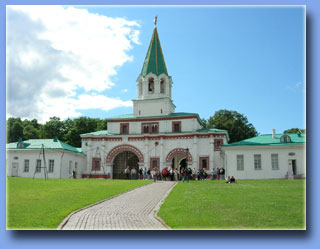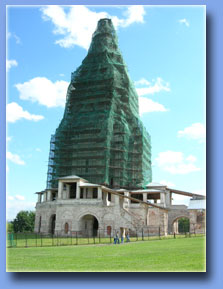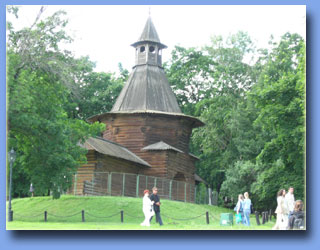MUSEUMS. Kolomenskoye Estate
-
39, Andropova Avenue
-
Metro station - Kolomenskaya
-
Open Tuesday through Sunday, from 10.00 am to 07.00 pm.
-
Closed on Monday.
|
|
 |
|
The Front (Palace) Gate.
It was the main entrance. Its construction dates from 1672 -1673. |
More photos of Kolomenskoye Estate
Kolomenskoye is a unique architectural ansemble of the Tsars former country residence that reserved its original layout structure situated on the high right shore of the Moskva River.
The history of this estate goes back to the 6th century B.C. Kolomenskoye was mentioned in the will of Moscow Prince Ivan Kalita in 1336. The village witnessed the triumphant return of Dmitry Donskoy's troops after they defeated the Tatars at Kulikovo in 1380. Peter the Great's troops also stopped here after their victory at Poltava in 1709. Kolomenskoye served for many years as a fortress defending the roads to Moscow. Legend has it that it was founded by the refugees from Kolomna who fled from the Tatar Khan in the early 13th century. Later the estate became the country residence of Russian princes and czars, including Ivan the Terrible and Peter the Great. Receptions for foreign ambassadors were also held here.
 |
|
Church of Ascension |
The earliest architectural monument on the estate is the Church of the Ascension built in 1532 by Grand Prince Vassily III to commemorate the birth of his son, the future tsar Ivan the Terrible. 200 feet of high it was one of the tallest Russian buildings in the 16th century and one of the stone churches in the Russian tent-roof style. The church also served as a watchtower. This church has a unique acoustics and festivals of orthodox music is annually carried out here. In 1994 the Church of the Ascension was included in the UNESCO List of the World Historical and Cultural Inheritance.
In 1640 the first tsar of the Romanov dynasty, Mikhail Fyodorovich, ordered the construction of a luxurious wooden palace at Kolomenskoye. It was built in a year entirely without saws or nails and it had 250 rooms and 3000 windows. Thirty years later a covered gallery connected the palace with the newly-built Church of Our Lady of Kazan, a striking blue-domed structure. The palace became known as the "eight wonder of the world" after additions made by Tsar Aleksey. In 1768 Catherine the Great torn down the palace and ordered the construction of a new palace near the Ascension Church. The Napoleonic invaders devastated Catherine's palace in 1812. The 1673 stone-made Palace Gate has survived to this days and greet visitors from the Moskva River.
 |
|
Entrance Tower of the Nikolo-Korelsky Monastery |
At present the expositions presenting various fund collections of the museum are shown in buildings of the 16-19th centuries: the Russian ancient painting works, art carving on wood, works of folk arts. Monuments of wooden architecture were moved to territory of Kolomenskoye from different places of Russia:
the Bratsky Stockade Tower built in the middle of the 17th century,
Small House of Peter the Great made by himself, the
Entrance Tower of the Nikolo-Korelsky Monastery with a watch tower and the gate made of wood without nail.
Those who are visiting Kolomenskoye may see a combination of world level architecture and landscape of a rare beauty:
400 years old oaks, the oldest trees in Moscow, reserved on this ancient land!
You are welcome to visit other museums in Moscow!
|